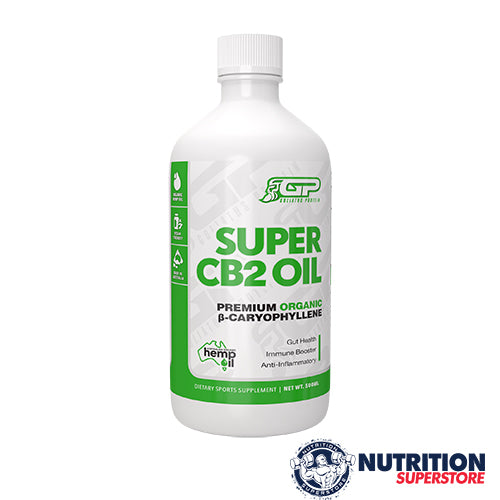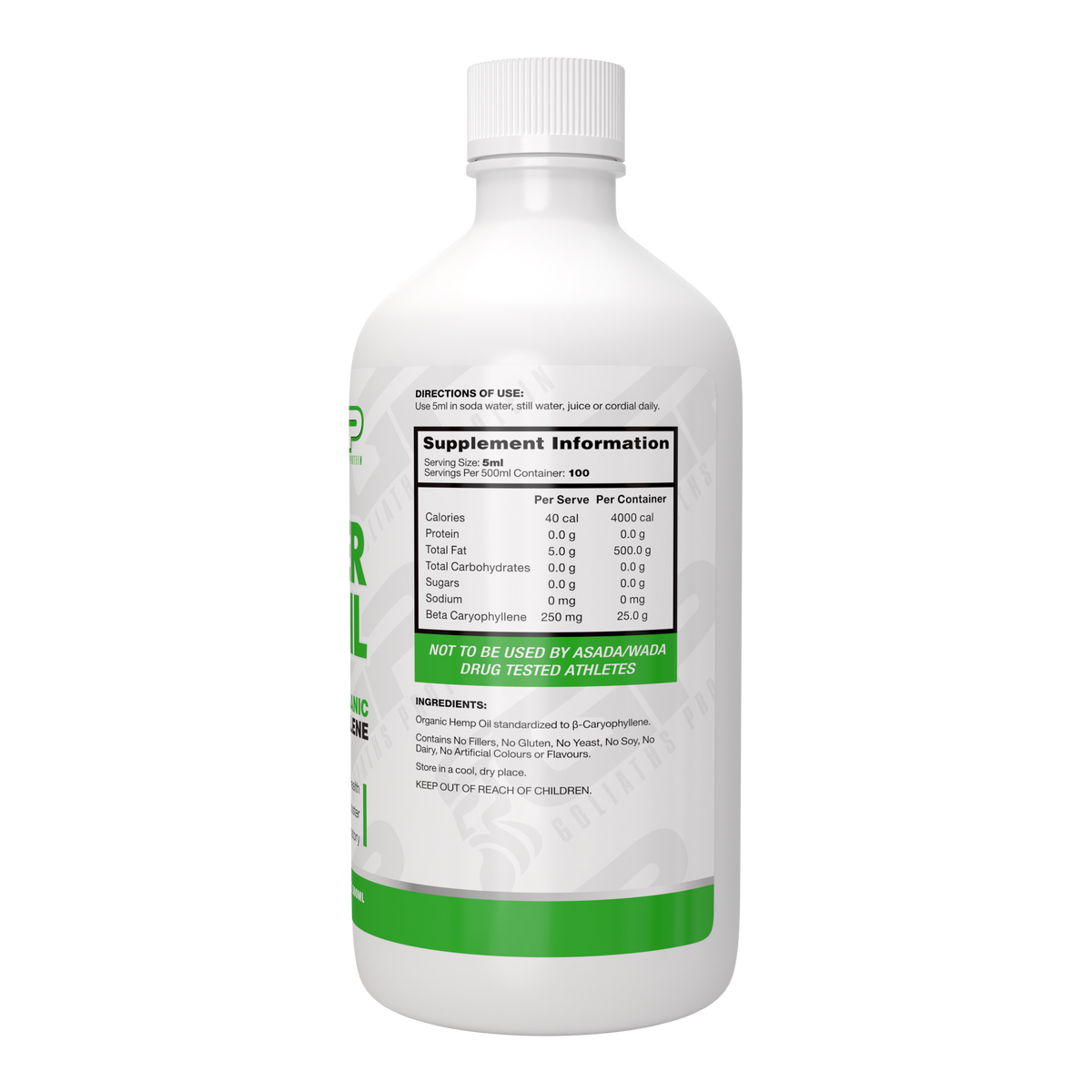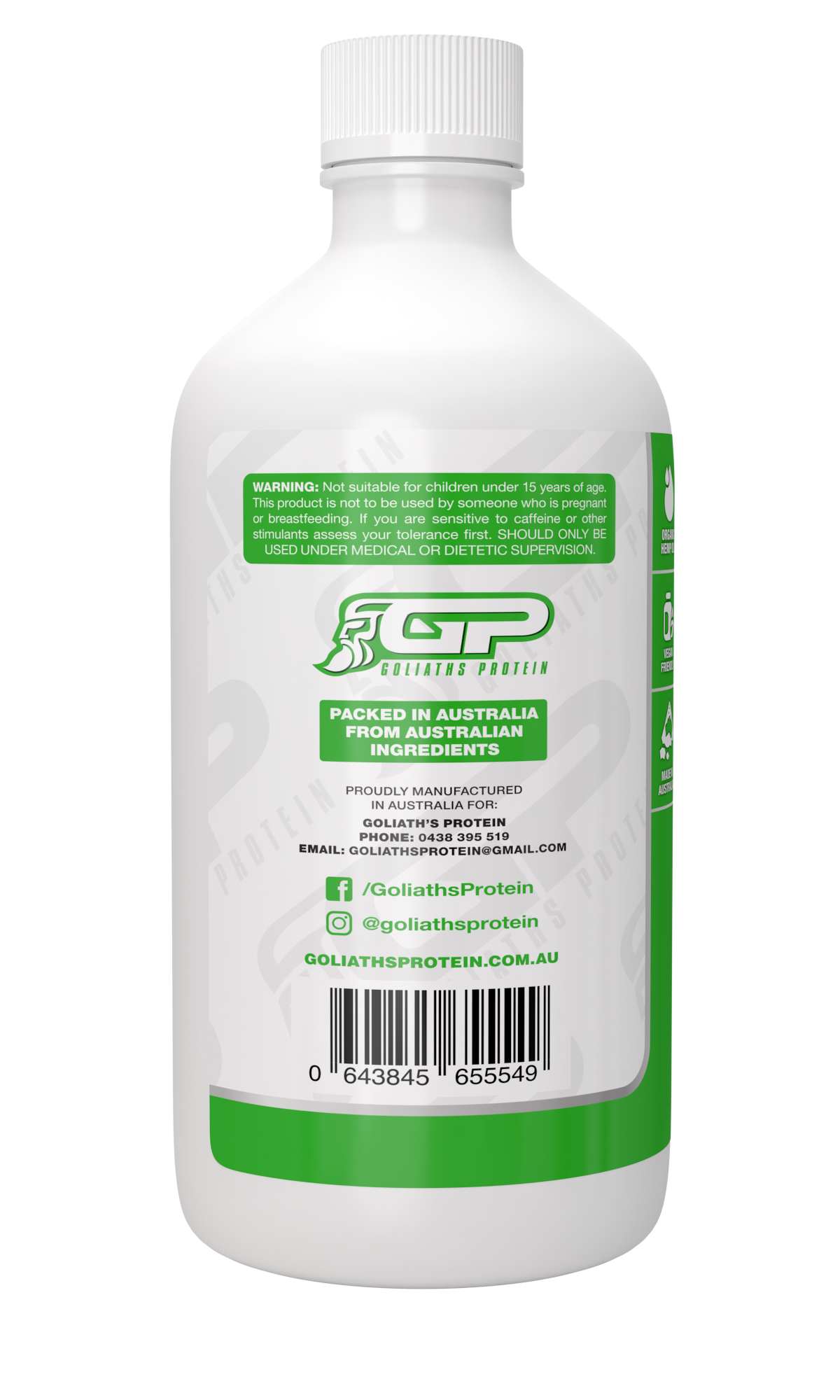Goliaths Protein
Super Hemp CB2 Oil
- Regular Price
- $79.95
- Sale Price
- $79.95
- Regular Price
- Unit Price
- Translation missing: en.general.accessibility.unit_price_separator
Australian CB2 Hemp Oil
Australian Cold Pressed Hemp Oil standardised to 50mg per ml of terpenes including, β-Caryophyllene and unrestricted cannabinoids.
Goliath's Protein Hemp CB2 Oil is a rich source of terpenes and fat soluble vitamins and unrestricted cannabinoids.
CB2 Oil may assist* in the protection of cells from free radical damage, normalise cell differentiation and improve immune function, promote healthy gut, aid anxiety and promote sleep. Omega fatty acids assist with general health including skin, immune function and inflammation. Terpenes have a range of therapeutic benefits including improving the symptoms of delayed onset muscle soreness and recovery.
*Hemp CB2 Oil is a rich source of omega 3 and 6 fatty acids, vitamins A and vitamin E. Terpenes are added to the specified levels.
Directions for Australian CB2 Hemp Oil
Servings per bottle: 50 servings.
Serving size: 5ml daily in water or juice
This product is only intended for healthy adults, 18 years of age or older. Consult your medical practitioner before using any dietary supplement. Do not take this product if you have any medical condition and /or are taking any medication. Do not use if pregnant or nursing (breast feeding). This product is not a sole source of nutrition and should be consumed in conjunction with a nutritious diet with an appropriate physical training or exercise program. Discontinue use and consult your health care professional if you experience any adverse reaction to this product. Do not use if safety seal is broken or missing. Keep out of reach of children.
EDUCATIONAL LITERATURE
Beta Caryophyllene (Terpene/Cannabinoid)
Type of Terpene: Sesquiterpene
Features.
|
§ Anxiolytic-like19 |
|
§ Anti carcinogenic17 |
|
§ Anti-inflammatory15 |
|
§ Antibacterial |
|
§ Anaesthetic16 |
|
§ Gastroprotective30,31,32 |
|
§ Analgesic9 |
|
§ Anti fibrotic18 |
|
§ Colitis11,24,25,26 |
|
§ Inflammatory hepatitis27,28,29 |
|
§ Nepthroprotective33,34,35 |
Educational Literature.
The sesquiterpene β-caryophyllene is a major plant volatile found in large amounts in the essential oils of many different spice and food plants such as oregano (Origanum vulgare L.), cinnamon (Cinnamomum spp.) and black pepper (Piper nigrum I.) 1-3
β-Caryophyllene selectively binds to the CP55,940 binding site (i.e., THC binding site) in the CB2 receptor, leading to cellular activation and anti-inflammatory effects. Although the CB1 receptor is expressed in the central nervous system and in the periphery, the CB2 receptor is primarily found in the peripheral tissues 4,5. In vivo, CB receptors are activated by arachidonic acid-derived endocannabinoids, such as 2-arachidonoyl ethanolamine (anandamide or AEA) and 2-arachidonoylglycerol (2-AG) 6,7. CB2 receptor ligands have been shown to inhibit inflammation and edema formation8, exhibit analgesic effects, 9 and play a protective role in hepatic ischemia -reperfusion injury10.
Educational Literature continued.
In the gastrointestinal tract CB2 receptor agonists have been shown to prevent experimental colitis by reducing inflammation11. Moreover, the CB2 receptor has been described as a potential target for the treatment of atherosclerosis 12 and osteoporosis13. Consequently, CB2 receptor-selective agonists that are devoid of the psychoactive side effects typically associated with CB1 receptor activcation are potential drug candidates for the treatment of a range of different diseases.
Several health effects have been attributed to β-caryophyllene or medicinal plants containing β-caryophyllene 14, including anti-inflammatory15, and anesthetic16, anti carcinogenic17, anti fibrotic18 and anxiolytic-like19 activity.
Analgesic effects of β-caryophyllene were also observed after local intraplantar application20. It has been previously shown that beta caryophyllene exerts an anti-inflammatory effect in the carrageenan-induced edema test21.
β-Caryophyllene is an extract of various plants and is one of the predominant cannabinoid receptor type 2 ligands found in cannabis sativa. β-Caryophyllene is a food grade additive and has demonstrated a wide range of activity22 and notably for gut health.
β-Caryophyllene is a known agonist for the PPARγ protein which is protective of several biological systems including gastrointestinal, inflammatory and metabolic systems. Several studies show the value of23 supplementation of β-Caryophyllene for:
- Colitis 24,25,26
- Inflammatory Hepatitis 27,28,29
- Gastroprotective 30,31,32
- Nephroprotective 33,34,35
Beyond generalised gastrointestinal and related organ health, β-Caryophyllene has been found to be cytoprotective and inhibited gastro-mucosal injuries and inflammation. There is evidence that the syndrome may be treated by36 β-Caryophyllene. Moreover, the medical cannabis community has suggested that the epidemic of ‘leaky gut’37 syndrome may be attenuated by the β-Caryophyllene content of marijuana extracts.38
Research Evidence and Efficacy
1Orav A, Stulova I, Kailas T, MQQrisepp M (2004) Effect of storage on the essential oil composition of Piper nigrum L. fruits of different ripening states. J Agric Food Chem 52:2582-2586
2Jayaprakasha GK, Jagan Mohan Rao L, Sakariah KK (2003) Volatile constituents from Cinnamomum zeylancium fruit stalks and their antioxidant activities. J Agric Food Chem 51:4344-4348.
3Mockute D, Bernotiene G, Judzentiene A (2001) The essential oil of Origanum vulgare L.ssp. vulgare growing wild in vilinius district (Lithuania). Phytochemistry 57:65-69
4Mackie K (2006) Cannabinoid receptors as therapeutic targets. Annu Rev Pharmacol Toxicol 46:101-122.
5(8Pertwee RG (2007) The diverse CB (1) and CB (2) receptor pharmacology of three plant cannabinoids: Delta (9)-tetrahydrocannabinol, cannabidiol and Delta (9)-tetrahydrocannabivarin. Br J Pharmacol 53: 199-215
6Devane WA, et al. (1992) Isolation and structure of a brain constituent that binds to the cannabinoid receptor. Science 258; 1946-1949
7Sugiura T, Waku K (2000) 2-Arachidonoyglycerol and the cannabinoid receptors. Chem Phys Lipids 108:89-106
8Iwamura H, Suzuki H, Kaya T, Inaba T (2001) In vitro and in vivo pharmacological characterization of JTE-907, a novel selective ligand for cannabinoid CB2 receptor. J Pharmacol Exp Ther 296:420-425
9Ibrahim MM, et al (2005) CB2 cannabinoid receptor activation produces antinociception by stimulating peripheral release of endogenous opiods. Proc Natl Acad Sci USA 102:3093-3098
10Batkai S, et al. (2007) Cannabinoid-2 receptor mediates protection against hepatic ischemia/reperfusion injury. FASEB J 21:1788-1800
11Kimball ES, Schneider CR, Wallace NH, Hornby PJ (2006) Agonists of cannabinoid receptor 1 and 2 inhibit experimental colitis induced by oil of mustard and by dextran sulfate sodium. Am J Physiol Gastrointest Liver Physiol 291: G364-371
12Steffens S, et al. (2007) Low dose oral cannabinoid therapy reduces progression of atherosclerosis in mice. Nature 434:782-786
13Ofek O, et al. (2006) Peripheral cannabinoid receptor, CB2, regulates bone mass. Proc Natl Acad Sci USA 103:696-701.
14Russo, E.B., 2011. Taming THC: potential cannabis synergy and phytocannabinoid-terpenoid entourage effects. Br. J. Pharmacol. 163,1344-1364
15Gertsch J., Leonti, M, Raduner, S., Racz, I., Chen, J.Z., Xie, X.Q., Altmann, K.H., Karsak, M., Zimmer, A., 2008. Beta-caryophyllene is a dietary cannabinoid. Pro. Natl: Acad. Sci. USA 105, 9099-9104.
Research Evidence and Efficacy.
16Ghelardini, C., Galeotti, N., Di Cesare Mannelli, L., Mazzanti, G., Bartolini, A., 2001. Local anaesthetic activity of beta-caryophyllene. Farmaco 56, 387-389.
17Legault, J., Pichette, A., 2007. Potentiating effect of beta caryophyllene on anticancer activity of a-humulene, isocaryophyllene and paclitaxel. J. Pharm. Pharmacol. 59, 1643-1647.
Loizzo, MR., Tundis, R., Menichini, F., Saab, A.M., Statti, G.A., Menichini, F., 2008. Antiproliferative effects of essential oils and their major constituents in human renal adenocarcinoma and amelanotic melanoma cells. Cell proliferation 41, 1002-1012.
18Calleja, M.A., Vieites, J.M., Montero-Meterdez, T., Torres, M.I., Faus, M.J., Gil, A., 2012. The antioxidant effect of beta caryophyllene protects rat liver from carbon tetrachloride-induced fibrosis by inhibiting hepatic stellate cell activation. Br. J. Nutr. 1, 1-8.
19Galdino, P.M., Nascimento, M.V.M., Florentino, I.F., Lino, R.C., Fajemiroye, J.O., Chaibub, B.A., de Paula, J.R., de Lima, T.C.M., Costa, E.A., 2012. The anxiolytic-like effect of an essential oil derived from Spiranthera odoratissima A. St. Hil. leaves and its major component, b-caryophyllene, in male mice. Prog. Neuropsychopharmacol. Biol. Psychiatry 38, 276-284.
20Katsuyama, S., Mizoguchi, H., Kuwahata, H., Komatsu, T., Nagaoka, K., Nakamura, H., Bagetta, G., Sakurada, T., Sakurada, S., 2012. Involvement of peripheral cannabinoid and opioid receptors in beta caryophyllene-induced antinociception. Eur. J. Pain 17, 664-675.
21Gertsch, J., Leonti, M., Raduner, S., Racz, I., Chen, J.Z., Xie, X.Q., Altmann, K.H., Karsak, M., Zimmer, A., 2008. Beta caryophyllene is a dietary cannabinoid. Proc. Natl. Acad. Sci. USA 105, 9099-9104.
Bento, A., Marcon, R., Dutra, R., Claudino, R., Cola, M., Leite, D., Calixto, J., 2011. Caryophyllene inhibits dextran sulfate sodium-induced colitis in mice through CB2 receptor activation and PPARy pathway. Am. J. Pathol. 178, 1153-1166.
Horvath, B., Mukhopadhyay, P., Kechrid, M., Patel, V., Tanchian, G., Wink, D.A., Gertsch, J., Pacher, P., 2012. B-caryophylllene ameliorates cisplatin-induced nephrotoxicity in a cannabinoid 2 receptor-dependant manner. Free Radic. Biol. Med. 52, 1325-1333.
22 Katsuyama, S., Mizoguchi, H., Kuwahata, H., Komatsu, T., Nagaoka, K., Nakamura, H., ... & Sakurada, S. (2013). Involvement of peripheral cannabinoid and opioid receptors in β-caryophyllene-induced antinociception. European journal of pain, 17 (5), 664-675.
23 Bento, A. F., Marcon, R., Dutra, R. C., Claudino, R. F., Cola, M., Leite, D. F. P., & Calixto, J. B. (2011). β-Caryophyllene inhibits dextran sulfate sodium-induced colitis in mice through CB2 receptor activation and PPARγ pathway. The American journal of pathology, 178 (3), 1153-1166.
24 Cho, J. Y., Chang, H. J., Lee, S. K., Kim, H. J., Hwang, J. K., & Chun, H. S. (2007). Amelioration of dextran sulfate sodium-induced colitis in mice by oral administration of β-caryophyllene, a sesquiterpene. Life sciences, 80 (10), 932-939.
Research Evidence and Efficacy.
25 Bento, A. F., Marcon, R., Dutra, R. C., Claudino, R. F., Cola, M., Leite, D. F. P., & Calixto, J. B. (2011). β-Caryophyllene inhibits dextran sulfate sodium-induced colitis in mice through CB2 receptor activation and PPARγ pathway. The American journal of pathology, 178 (3), 1153-1166.
26 Cho, J. Y., Choi, E. H., Kang, J. I., Choi, C., & Chun, H. S. (2013). Supercritical fluid extract from maca alleviates colitis induced by dextran sulfate sodium in mice. Food Science and Biotechnology, 22 (3), 859-864.
27 Chaieb, K., Hajlaoui, H., Zmantar, T., Kahla-Nakbi, A. B., Rouabhia, M., Mahdouani, K., & Bakhrouf, A. (2007). The chemical composition and biological activity of clove essential oil, Eugenia caryophyllata (Syzigium aromaticum L. Myrtaceae): a short review. Phytotherapy Research: An International Journal Devoted to Pharmacological and Toxicological Evaluation of Natural Product Derivatives, 21 (6), 501-506.
28 Varga, Z. V., Matyas, C., Erdelyi, K., Cinar, R., Nieri, D., Chicca, A., ... & Hasko, G. (2018). β-Caryophyllene protects against alcoholic steatohepatitis by attenuating inflammation and metabolic dysregulation in mice. British journal of pharmacology, 175 (2), 320-334.
29 Varga, Z. V., Matyas, C., Erdelyi, K., Cinar, R., Nieri, D., Chicca, A., ... & Hasko, G. (2018). β-Caryophyllene protects against alcoholic steatohepatitis by attenuating inflammation and metabolic dysregulation in mice. British journal of pharmacology, 175 (2), 320-334.
30 Paiva, L. A. F., Rao, V. S. N., Gramosa, N. V., & Silveira, E. R. (1998). Gastroprotective effect of Copaifera langsdorffii oleoresin on experimental gastric ulcer models in rats. Journal of ethnopharmacology, 62 (1), 73-78.
31 Sharma, C., M Al Kaabi, J., M Nurulain, S., N Goyal, S., Amjad Kamal, M., & Ojha, S. (2016). Polypharmacological properties and therapeutic potential of β-caryophyllene: a dietary phytocannabinoid of pharmaceutical promise. Current pharmaceutical design, 22 (21), 3237-3264.
32 Lemos, M., Santin, J. R., Mizuno, C. S., Boeing, T., Sousa, J. P. B. D., Nanayakkara, D., ... & Andrade, S. F. D. (2015). Copaifera langsdorffii: evaluation of potential gastroprotective of extract and isolated compounds obtained from leaves. Revista Brasileira de Farmacognosia, 25 (3), 238-245.
33 Horváth, B., Mukhopadhyay, P., Kechrid, M., Patel, V., Tanchian, G., Wink, D. A., ... & Pacher, P. (2012). β-Caryophyllene ameliorates cisplatin-inducednephrotoxicity in a cannabinoid 2 receptor-dependent manner. Free Radical Biology and Medicine, 52 (8), 1325-1333.
34 Sharma, C., M Al Kaabi, J., M Nurulain, S., N Goyal, S., Amjad Kamal, M., & Ojha, S. (2016). Polypharmacological properties and therapeutic potential of β-caryophyllene: a dietary phytocannabinoid of pharmaceutical promise. Current pharmaceutical design, 22 (21), 3237-3264.
Research Evidence and Efficacy.
35 Loizzo, M. R., Tundis, R., Menichini, F., Saab, A. M., Statti, G. A., & Menichini, F. (2008). Antiproliferative effects of essential oils and their major constituents in human renal adenocarcinoma and amelanotic melanoma cells. Cell Proliferation, 41 (6), 1002-1012.
36 Tambe, Y., Tsujiuchi, H., Honda, G., Ikeshiro, Y., & Tanaka, S. (1996). Gastric cytoprotection of the non-steroidal anti-inflammatory sesquiterpene, β-caryophyllene. Planta medica, 62 (05), 469-470.
37 Wright, K. L., Duncan, M., & Sharkey, K. A. (2008). Cannabinoid CB2 receptors in the gastrointestinal tract: a regulatory system in states of inflammation. British journal of pharmacology, 153 (2), 263-270.
38 Boyar, K. Leaky Gut Syndrome: Cannabinoids and the Endocannabinoid System (ECS) as a therapeutic target.
Customer Reviews
Add text which will be shown in tabs across all product pages



